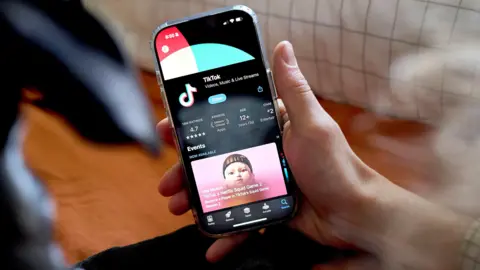The recent trends surrounding TikTok in the United States reveal a significant increase in unofficial downloads of the app amidst ongoing uncertainty regarding its future. As social media platforms face growing scrutiny, TikTok has become a focal point of legal and political conversations, particularly following an executive order from former President Donald Trump. This order allows the continued use of the app in the U.S., despite the Supreme Court’s decision to uphold a law that could lead to the app being sold or outright banned. This legal backdrop has made the dynamics around its accessibility quite complicated.
In response to the apprehensions surrounding TikTok’s legitimacy, major tech companies like Apple and Google have ceased allowing new downloads from their official app stores. Consequently, many users have opted for a method known as “sideloading”—a process that entails downloading applications from third-party sources rather than official platforms. This technique has gained traction in the wake of recent restrictions. A prominent example of a service facilitating this process is Signulous, which reports that over 120,000 users have sought its aid to download TikTok onto their iPhones. Neil Pomperleau, a representative from Signulous, noted an extraordinary surge of downloads, sometimes exceeding 2,000 per hour, as users flock to sideloading to access the app.
As restrictions tighten, many TikTok enthusiasts have turned to virtual private networks (VPNs) to bypass geographical limitations. By employing VPNs, users trick the system into believing they are located in countries where such bans are not in effect, enabling continued access to TikTok. Recent data from Google indicates that searches for VPN services peaked in the last month, underlining a heightened interest among users eager to maintain their connection to the platform. Concurrently, various YouTube tutorials on how to sideload the app have amassed hundreds of thousands of views, signifying a concerted effort by users to navigate around the restrictions imposed by tech giants.
The legality of these sideloading processes remains a contentious topic. Current U.S. law dictates that while distributing TikTok is indeed illegal, both Trump and his successor, President Joe Biden, have expressed that they would not enforce such measures, leading to a somewhat chaotic regulatory landscape. Sideloading firms like Signulous operate within a legal gray zone, providing a service where users can navigate the technicalities of installing apps. While this method may come with added risks of downloading defective or malicious software, the allure of accessing a discontinued app has spurred many to take that leap.
Interestingly, TikTok appears to affirm this non-enforcement stance as it has recently launched a download kit aimed at simplifying the sideloading process for Android users. Notably, sideloading on Android devices presents fewer complications compared to iPhones, which largely depend on the secured iOS platform. Not only Signulous but also a similar firm, AppDB, reported a significant spike in downloads—nearly 95,000 since the announcement of the ban—highlighting the public’s persistent demand for the app.
However, Apple remains staunch in its position regarding the risks associated with sideloading, continuing to advocate for stringent vetting processes for app approvals on its platform. By maintaining a 30% commission on apps distributed via its App Store, Apple argues that these measures serve to protect consumers from potential perils associated with unauthorized applications. Nonetheless, the company faces increasing pressure to adapt to evolving regulations, particularly from the European Union, where it has been mandated to permit alternative app stores on its devices.
The phenomenon of sideloading raises broader questions about enforcement and user rights in an age of technological advancement. As the landscape of app distribution continues to evolve, the sustained interest in TikTok signals that consumers are increasingly willing to innovate their strategies in order to access desired content, regardless of the potential legal ramifications involved. In essence, TikTok’s presence continues to thrive in an environment of uncertainty, consistently pushing the boundaries of conventional app distribution norms.










